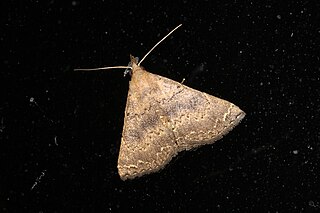
Hypena is a genus of moths in the family Erebidae. It was first described by Franz von Paula Schrank in 1802. These non-migratory moths overwinter as pupae and almost never estivate as adults.

Renia is a genus of litter moths of the family Erebidae erected by Achille Guenée in 1854.
Maracayia chlorisalis is a species of moth in the family Crambidae that was first described by Francis Walker in 1859. It is found from North America through Costa Rica southwards at least to Brazil.

Dichromia is a genus of moths of the family Erebidae first described by Achille Guenée in 1854.

Ommatospila narcaeusalis, the ommatospila moth, is a moth of the family Crambidae described by Francis Walker in 1859. It can be found in the southern parts of the United States, South America and several Caribbean islands, such as the Antilles and Jamaica.

Poliobotys is a monotypic moth genus of the family Crambidae described by Jay C. Shaffer and Eugene G. Munroe in 2007. Its single species, Poliobotys ablactalis, was described by Francis Walker in 1859. It occurs throughout South-east Asia, including Réunion, Australia, Hong Kong and Africa.

Banisia myrsusalis, the sapodilla borer or sapota midrib folder, is a species of moth of the family Thyrididae. It was described by Francis Walker in 1859 and is found in North America, Brazil, Australia, southern Asia and Africa.
Dichromia quinqualis is a moth of the family Erebidae first described by Francis Walker in 1859. It is found in the South Pacific including: Fiji, Queensland and Java.

Dichromia sagitta is a moth of the family Erebidae first described by Johan Christian Fabricius in 1775. It is found in India, Macau, Hong Kong, Japan and Taiwan.
Avitta ophiusalis is a moth of the family Noctuidae first described by Francis Walker in 1859. It is found in Indian subregion, Sri Lanka, China, Japan, Sundaland, Sulawesi, Queensland, Solomon Islands, Vanuatu, Fiji and New Caledonia.

Progonia oileusalis is a moth of the family Noctuidae first described by Francis Walker in 1859. It is found in Sri Lanka, Borneo, India, Taiwan, Japan and the Philippines.

Dichromia orosia, sometimes as Dichromia sagitta, is a moth of the family Erebidae first described by Edward Meyrick in 1913. It is found in Sri Lanka and Australia. The caterpillar is a pest of Marsdenia species, Tylophora asthntatica and Tylophora indica.

Dichromia pullata is a moth of the family Erebidae first described by Frederic Moore in 1885. It is found in Sri Lanka and India.
Dichromia cognata is a moth of the family Erebidae first described by Frederic Moore in 1885. It is found in Sri Lanka, India, Hainan, Borneo, New Guinea, Bismarck Islands, Solomon Islands and Vanuatu.
Dichromia occatus is a moth of the family Erebidae first described by Frederic Moore in 1882. It is found in the Indian subregion, Sri Lanka, Taiwan, Japan, Korea, Laos, Borneo, the Philippines, Sulawesi, Java and Bali.
Dichromia thermesialis is a moth of the family Erebidae first described by Francis Walker in 1866. It is found in India, Sri Lanka, China, Sumatra, Borneo and New Guinea.
Hypena mandatalis, is a moth of the family Erebidae first described by Francis Walker in 1859. It is found in the Indian subregion, Pakistan, Sri Lanka, Borneo, Sulawesi and Australia.









